2014-11-25 By Ed Timperlake
Previous Introduction
21st century warfare technologies concepts of operations and tactics and training are in evolution and revolution.
At the heart of reshaping US and allied approaches to airpower and its evolution is the emergence of the F-35, the significant impact which a global fleet of F-35s will have on US and allied capabilities and the approaches to leveraging other capabilities in the warfighting tool kit.
There is always the reactive enemy, so that the roll out of new approaches shaped by the impact of the F-35 will see reactions from various competitors and responding to these reactions will part of the re-set of evolving US and allied airpower and combat approaches.
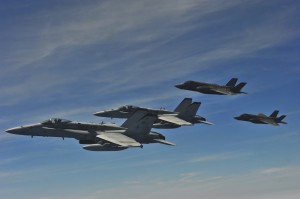
The F-35 is at the heart of change for a very simple reason – it is a revolutionary platform, and when considered in terms of its fleet impact even more so.
The F-35, Lightning II, has a revolutionary sensor fusion cockpit that makes it effective in AA, AG and EW.
US and Allied Combat pilots will evolve and share new tactics and training, and over time this will drive changes that leaders must make for effective command and control to fight future battles.
An issue has been that the F-35 has been labeled a “fifth generation” aircraft, a sensible demarcation when the F-22 was being introduced.
But the evolution of the combat systems on the aircraft, the role of the fusion engine, and the impact of a fleet of integrated F-35s operating as a foundational element will make this term obsolete.
The global fleet of F-35s will be the foundation for a fundamental change in the way air power operates and with it overall combats concepts of operations for the US and allied insertion forces.
It is not an in and of itself platform; it is about what an integrated fleet of F-35s can deliver to TRANSFORM operations.
The decade ahead can be very innovative if what the fleet brings to the fight is learned and applied and the combat warriors leverage what they learn and then the application of those lessons to reshaping the force are applied.
As a senior RAF pilot involved with the F-35 program has put it well: “While much of the world still debates the existence of the F-35, we are moving rapidly forward to figure out how to use the aircraft and leverage it.”
At the heart of the transformation is the combination of two powerful trends: the emergence of Tron warfare and the forging of a combat cloud integrating combat capabilities.
The F-35 fleet operates at the cutting edge of both.
Part Two Begins:
The F-35 and the Aviation Design Cycle
In the opening days of US combat in World War II, extremely courageous Navy and Marine pilots went up against the Imperial Japanese Navy in inferior aircraft. For the Marines, the F2A Brewster Buffalo was woefully inadequate at the Battle of Midway and an entire Navy torpedo squadron, Torpedo-8 except for a single pilot, was killed in combat.
However, independent of technological aircraft short comings, the aircrews of Torpedo-8 did not die in vain, Ensign George Gay was the sole survivor, because all the Japanese fighter were pulled down to sea level.
In searching for the main Japanese Carrier strike force LCdr. Wade McClusky leading the USS Enterprise bombing group at altitude saw the wake of a Japanese Destroyer and followed it to the enemy carriers. USN dive bombers could then concentrate on their targets unimpeded by Japanese fighters.
With the entire world in combat and nations fighting for their very existence, aircraft design teams pressed ahead with all the resources and intellectual vision they could bring to the design table. What the U.S. air forces introduced during those years was a steady introduction of type, model, and series (T/M/S) of always improving airborne killing machines.
From the F2-A Brewster Buffalo to the F-4F and F-4U to the F-6 and at wars end, the F-8 Bearcat the Navy had a series of prop driven Fighters that mastered the Japanese Zero. The Army Air Corps went from P-39 to P-38 Lighting, P-47 Thunderbolt to the P-51 Mustang with its wonderful bubble canopy to carry the fight to the heart of Germany.
Along the way emphasis was placed on pilot survivability by putting armor plates in the cockpit and having self-sealing fuel tanks. Since the entire objective was to get first “tally” and then out maneuver the enemy to kill him, the total design focus was to always improve a blend of speed, range, and maneuverability—better engines and smarter airframe designs.
Of course, while the main effort was producing enough “motors and gun sights,” industry and research lab efforts were underway to change yet again the technology of the air fight.
The P-61 “Black Widow” was an early attempt to put radar on a night fighter, and the Germans tried a rocket plane against B-17 formations. The Italians Germans, Brits and, ultimately, Americans experimented with early jet engines. The German ME-262 changed the dynamics of combat. Although, the Germans employed it in an inefficient manner in following Hitler’s call for it to be committed to an air to ground role.
After WWII, the jet engines started the same dynamic seen in the prop years –improved airframe system performance by improving speed, range and maneuverability.
But two new dynamics were added both related to “payload”.
For a fighter in WWII, the “payload” was simple –what caliber and how many machine guns or cannons fit the design to give the pilot enough “deadly bursts” to kill several of his opponents.
In the jet age, the complexities of adding airborne systems and improving the weapons carried, changed the technology vectors of design considerations and introduced two more synergistic, but relatively independent research and development paths.
Airborne radar and sensors were added to fighters and those systems helped the payload—guns and early IR fire and forget missiles became more efficient with the AIM 9 sidewinder series.
But then, concurrently, independent performance was put into the payload by improving missiles and linking long-range (BVR) missile shots to radar technology. At first, radar guided missiles needed continuous guidance from the fighter but eventually even radar guided missiles became BVR self-contained “fire and forget.”
So unlike WWII research and development, where research on airframes and engines was the mantra, in the jet age there were two other huge design factors at work.
The first was always questing to improve the radar systems in the fighters and, secondly, as technology allowed independent designs could improve the weapons carried. Yet again, the art of aeronautical design had to work in partnership with the science of military R&D.
Along the way survivability shifted from armor, speed, and focusing on a good canopy into the era of Electronic Warfare and now the incorporation of stealth characteristics through both design considerations, composite materials and the wonders of chemistry for paint.
Stealth is a survivability factor and is critically important because it multiplies the effectiveness of the fighter—one doesn’t add stealth but incorporates it into the very existence of the fighter. Being a multiplying factor means it is sensitive and can really drive the entire performance of the airframe and system combat performance.
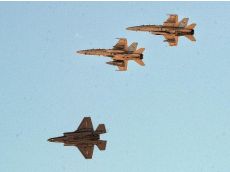
So ending the 20th Century the complexities of fielding the best fighter was a much bigger challenge because of three synergistic but independent factors — basic airframe performance improvements, internal system R&D and constantly improving weapons.
However, with the very real computer revolution moving with light speed into the 21st Century there is now a forth design dynamic at work —the man-machine interface.
With the very real capability of three-dimensional sensing and being able to distribute information to other warfighters (airborne and on the ground or at sea), the relationship of the individual pilot to knowledge of the bigger air battle is truly revolutionary.
For example, one of the most important capabilities of the F-35 is the distributed information capability. The least experienced fighter pilot to the most experience all are flying into the air battle in yet to be developed formations are all equally capable of having the same knowledge and situational awareness.
Consequently in the formation if one pilot gets inside the opponents OODA loop (observe orient decide act) all are capable of having that same joint knowledge. The revolutionary point is the enemy can splash an individual F-35, but cannot kill the knowledge gained by all: that aspect of modern warfare is truly unique 21st Century technology brought to an air battle.
Conversely, on the offensive if one F-35 picks up an enemy’s airborne vulnerability such as an aircraft system or weapon frequency emission or stealth breakdown it can be sent to all. Thus, another unique aspect of F-35 21st Century capabilities is that every Lightning II is a real time intelligence collection system. The entire engagement is also captured electronically for immediate and direct refinements to tactics and analysis during the air battle.
Fleet wide information sharing among services and allies will be a huge factor in winning an air campaign.
Recognizing and exploiting man-machine three-dimensional knowledge is truly a brave new world.
Consequently, the F-35 is capable of constantly updating this next generation of U.S. fighters but not by building a new airframe but staying inside the F-35 basic airframe and adding the next generation of systems and weapons with soft-ware upgradeable programs.
The learning curve to improve F-35 sensors, systems capabilities and weapons carried compared to building another airframe is a new American way of industrial surging. The American arsenal of democracy is shifting from an industrial production line to a clean room and a computer lab as key shapers of competitive advantage.
The Training Challenge for 21st Century Con-Ops
The challenge at all times is to prepare for the future with the forces available. Just like the evolution of technology for generational clustering of ever improving combat aircraft the training has to be flexible to fight the force as generations shift.
The Navy training with regard to the F-4 at “Top Gun” is a perfect example. While many services and allies were flying the F-4, Top Gun was the place where the ability of the aircraft was really understood. Since the Israeli Air Force had had combat success with the F-4 they very generously shared their flying tactics.
The focus at “Top Gun” was the Air-to-Air Mission, even though the F-4 was also proficient in air-to-ground. The Marines MAWTS process also kept focus on AG by the nature of their requirement to always support ground combat troops.
Over time the Phantom was replaced by the F-14 but the Navy still had an “Attack Community” flying A-6 and A-7 Aircraft. The Marines stayed with F-4 and AV-8 and the Air Force introduced the F-15, F-16 and kept the A-10. Both the F-15 and F-16 were superb AG aircraft.
The most interesting technology training and tactics evolution was in the introduction of the 4th Gen F/A-18. The designation of “F” for fighter and “A” for attack in the same aircraft changed everything as the Navy and Marines adjusted. Since the Marines kept their AV-8 Harriers they still had a designated CAS/GA attack aircraft.
But for the Navy everything changed as the A-7 was phased out and eventually the A-6 and F-14. Consequently the Navy had to adjust during an airframe generational shift to successfully integrating a well designed from its conception multi-mission aircraft, the Hornet.
The History of the USN “Grim Reapers” shows this progression of type/model/series (TMS).
The F-4, which evolved into a multi-mission platform, began life as an interceptor. The F/A-18 Hornet began life with both an “F” and an “A”, and in a very practical sense the F/A-18 forced two communities to join together. The Navy “Fighter” community and “Attack Community” were completely different even operating from different Naval Air Stations and only come together in exercises and as part of a Carrier Air Group” when deployed.
Navy leaders figured all this out and created a multi-disciplined curriculum at NAS Fallon. But Fallon is much more than just “Top Gun.” Fallon Naval Air Station is in the desert of Nevada. It is where the Navy trains for the advanced tactics for core air platforms but most importantly shapes its integration of the air wing prior to going to sea for final preparation for combat. Naval Strike and Air Warfare Center (NSAWC) is known in the Navy as “Strike University.” Strike U was set up to deal with combat failures of naval aviation, and to shape better tactics, training and concepts of operations to prevail going forward.
As the head of NSAWC, Admiral Scott Conn, noted in an interview:
The mission we have here started with TOPGUN, 45 years ago. TOPGUN was founded out of failures in combat during the Vietnam War. TOPGUN training led to measurable improvements in Air-to-Air kill ratios.
Additionally, as a result of failures in combat in Lebanon, STRIKE University, now call simply Strike, was stood up in 1984 to target training at the integrated warfighting level. Through the years, other communities have mirrored the TOPGUN model including the EA-18G HAVOC course, the E-2 CAEWWS course, and the H-60S/R SEAWOLF course.
These courses target advanced training at the individual level. We have learned a lot of lessons at Fallon and we have had a lot of time to shape an effective combat learning environment. Bottom line: My job here is to prepare our forward deployed air wings to fight and win in a wide variety of missions across the globe.
With the coming of the F-35 and the evolution of the threat envelope in the next decade, the USN is changing its training approach.
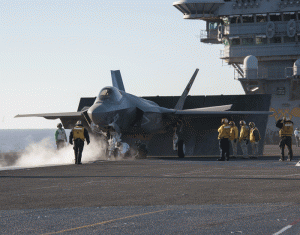
And in so doing, they will establish a framework more appropriate to developing, and executing 21st century concepts of operations.
As Admiral Conn put the challenge:
I think it important to emphasize that adversary A2AD capabilities pose a serious threat not only to Navy, but to our entire Joint ability to fight and win.
I think of A2AD as the proliferation of precision for potential adversaries and how this proliferation of precision effects joint forces ability to maneuver where we need to be and when we need to be there.
For me, it is about expanding the battlespace and training with regard to how to do this.
Training for an expanded battlespace means that the extensive ranges at Fallon are not enough to train to prevail in the evolving battlespace.
This is why the Navy is spearheading a broad effort to expand the envelope of training to combine live training with what is called Live Virtual Constructive training. What is entailed is folding in red and blue assets to shaping an evolving strike integration training process.
As Captain McLaughlin, the outgoing CO of Strike, explained in an interview with Second Line of Defense:
The current Fallon ranges – although large – are too small to train against an advanced threat, which can shoot longer than the ranges. We need to train to a 21st Century Plus type of threat with very long-range missiles in the mix.
It is not about succeeding; it is about how we are going to do this with highest probability of success.
We are rolling in Live Virtual Constructive Training to provide the extenders for our operators to work in that threat environment and to reach out to other assets – Navy and joint – which can allow us to fight in an expanded battlespace.
Rear Admiral Mike Manazir, the Admiral responsible for the future air systems of the US Navy, perfectly describes Live Virtual Constructive Training:
Live, virtual, constructive (LVC) training is a way to put together a representation of the threat baseline where you can train to the very high end using your fifth generation capability. Some of it is live with a kid in the cockpit, some of it is virtual in a simulator, and so “virtual” is actually the simulator environment. And then constructive is a way to use computers to generate a scenario displayed on either or both of the live or simulated cockpit.
You can also combine them to be live-constructive, or virtual-constructive, and by that I mean there are systems out there right now that you can install in the airplane that will give you a constructive radar picture air-to-air and surface-to-air along with the electronics effects right onto your scope.
You’re literally flying your airplane, and through a data link, you can share that information between airplanes, you can share it between dissimilar airplanes.
You could take a set of Navy airplanes, for instance, an E2D and a division of F-18s or F-35s on the Fallon range. And you could have a constructive scenario that is piped into all five of those airplanes.
It’s the same scenario, has all the same effects. And then the blue players can act according to that constructive scenario, and react to that constructive scenario in the live environment, but there’s nothing real in front of them…the threat is all simulated by computer generation.
Now let’s say that through fiber network, you pipe that constructive picture over to a coalition partner…for example, you do so to the RAAF in Australia…it is piped to a live airplane or a simulator over there, and let’s say there’s two Australian airplane simulators, and they’re seeing the same picture as the Americans are fighting.
And let’s say that there is a network that goes to the Aegis Cruiser, which is off the coast of Florida, and is going to be their Aegis Cruiser for the training. And you can show them the same picture.
And you can transmit the comms across that. You can easily see the training power in this LVC construct.
There are other systems that will allow you to have a live wingman up in the air in Fallon or on another range, his lead in a simulator, and when the simulator lead looks at his or her visual, he can see a virtual representation of his live wingman doing everything he does in the aircraft , and a link sends the aircraft maneuvers down to the simulator.
And when the simulator or the live person looks through their enhanced Joint Helmet Mounted Queuing System, he can see a virtual airplane on his visor.
When the virtual airplane on the helmet system say, dumps a flare or drops ordnance against the target, you actually see it come off the airplane in your visor.
And you can actually fight a virtual bogey on your visor, and the guy’s not there. And you fight it with your airplane, just as if it is a real piece of metal. So that’s the live-constructive piece.
If you optimize the networks so that you have a live airplane flying somewhere, a simulator that’s exactly what emulates a live airplane, and then a constructive scenario that goes to both you now have the full LVC construct. You can overcome the barriers of geography, if the range is not big enough. You could also overcome the barriers of multilevel security, because if you go up and use all of your weapons system modes up in the air, live, there are surveillance systems that can pick up what you’re doing.
In this way, you can protect high end modes with encryption, and then create an architecture where LVC allows you to train to the complete capability of your fifth generation platform integrated into the advanced air wing and connected to AEGIS and the aircraft carrier as well as operations centers ashore. And that’s what we’re looking to do.
We realize that the fifth generation platform has now bumped us up against the limits of our training ranges and that we do not quite have the LVC components built yet, so that is where our current focus lies.
And in that interview, the head of N-98 highlighted that recently the USN headed a government wide group looking at the approaches to shaping and implementing VLCT across the combat enterprise.
The F-35 is a key element of shaping Navy thinking about operating in an expanded battlespace.
Aviation leadership is looking forward to the impact of F-35 on the evolution of the strike fleet, much as a leaven for change than the sum and substance of that change.
Again, as Admiral Conn put it:
“Looking forward, we need to continue to provide trained and ready aircrew to operate forward. In five years we are going to have JSF in the fleet.
In five years we may have UCLASS on our carriers. In five years, the Super Hornet of today is going to be different. In five years the E-2D capabilities and our networks will have matured. In five years the threat is going to change and competitors will have more capability.
In working with Naval Aviation Leadership, we are on a journey of discovery of how to best create a training environment that replicates potential adversary’s capabilities.”
Training to operate in the expanded battlespace is a key requirement to deal with the threat and to leverage what the F-35 brings to the force and to an ability to tap into the entire panoply of joint and coalition warfighting assets to deal with 21st century challenges.
The Marines are experiencing a similar transformation at Yuma MCAS as they bring the F-35B on line and prepare for IOC next year.
According to the Executive Officer of the VMFA-121, Green Knights, Major Gregory Summa:
In the F-35, the fusion engine does a lot of that in the background, while simultaneously, I can be executing an air-to-air mission or an air-to-ground mission, and have an air-to-air track file up, or multiple air-to-air track files, and determine how to flip missions.
Because the fidelity of the data is there right now, which allows me to determine if I need to go back into an air-to-air mindset because I have to deal with this right now as opposed to continuing the CAS mission.
And I have a much broader set of integrated tool sets to draw upon. For example, if I need an electronic warfare tool set, with the F-18 I have to call in a separate aircraft to provide for that capability. With the F-35 I have organic EW capability. The EW capability works well in the aircraft. From the time it is recognized that such a capability is need to the time that it is used requires a push of a button. It does not require that a supporting asset be deployed.
Question: Obviously your pilots need to be trained to combine the air-to-air and CAS capabilities and to use the new organic tools sets as well?
Major Summa: It does. Now we’re going to have a pilot that’s versed in doing CAS, if he needs to use the electromagnetic spectrum or exploit it to accomplish his mission, he’ll be educated and have the equipment to do so.
If he needs to use it in the air-to-air arena to exploit it, to accomplish his mission, he’ll have the training and the equipment needed to use it as well.
In the current situation, I would deploy a Prowler to work with my legacy fighters. The Prowler would have to be sortied and would operate only for a period of time and in a specific operational area. With the low observability of the F-35 combined with the organic EW capability of the aircraft, the aircraft expands my capabilities for both air-to-air and CAS.
With respect to different but similar pilot cultures Major Suma captures that US way of war and the training for combat:
Working with the other service pilots provides an important window on where we want to go with the concepts of operations of the aircraft.
We have different backgrounds — Harrier, F-18s, F-16s, F-22s and F-15s — but we understand that, given the commonality of the aircraft, these different backgrounds suggest common ways ahead. We are all able to contribute to the way ahead for a common aircraft.
Operating on the Z Axis
The F-35 is known as a 5th generation player in the state-of-the-art for both the Air-to-Air Fighter, and Air-to-Air Attack combat roles. It also adds an “electronic” or “tron” warfare component to the fight–the Z Axis and the “Fusion Engine”
This is the beginning of a combat aircraft design that is building along a new axis-the “Z-axis.” The “Z axis” is a core discriminator.
The F-35 aircraft is not a linear performance enhancement from F/A-18 4th Gen; it has a third performance axis “Z.”
The “Z” axis is the pilot’s cockpit C4ISR-D (for decision) loop axis.
Starting at the beginning air fleet Command and Control from WWI on it has morphed into C5ISR (useful but getting silly) – Command, Control, Communications, Computers, Combat Systems, Intelligence, Surveillance, and Reconnaissance
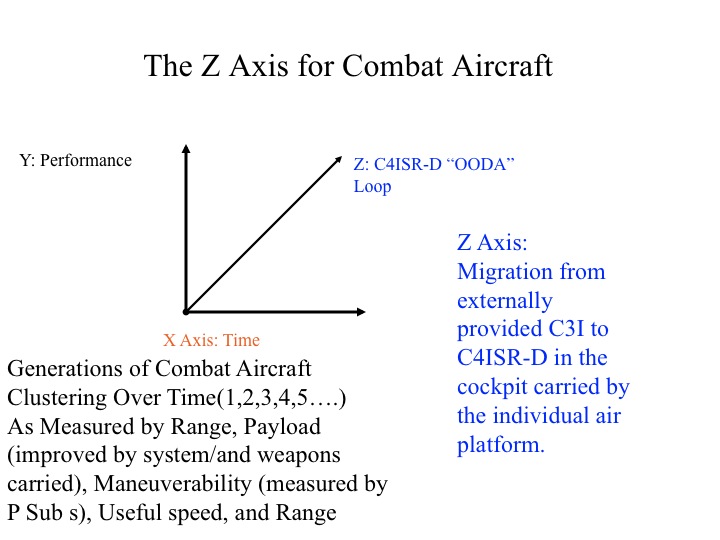
Traditionally, in looking at the progression of aircraft a two-dimensional design depiction has been used; the x-axis is time and the y-axis is performance.
That graph captures individual airplanes, but they do tend to cluster in generation improvement. Each aircraft clustered in a “generation” is a combination of improvements.
The aeronautical design “art” of blending together ever improving and evolving technology creates improvements in a linear fashion, if not performance would eventually go asymptotic.
The airframe design characteristics blended together prior to F-35 have been constantly improving range, payload (improved by system/and weapons carried), maneuverability (measured by P Sub s), speed, and range (modified by VSTOL–a basing mobility plus factor).
The F-35 is also designed with inherent survivability factors, redundancy and hardening and stealth. Stealth is usually seen as the 5th Gen improvement.
But reducing the F-35 to a linear x-y axis improvement simply misses the point.
The F-35 is now going to take technology into a revolutionary three-dimensional situational awareness capability. This capability establishes a new vector for TacAir aircraft design.
This can be measured on a “Z” axis.
Historically, Command and Control (C&C) was external to 1,2,3, 4th and some 5th Generations of TacAir. Now known as C5ISR the goal was still enhancing fleet wide combat performance for all Type/Model/Series (T/M/S) of TacAir.
This is the current modern AWACS (hub and spoke) battle management concept. But by using a three-dimensional graph, one can understand that the “Z-axis” takes airpower into a totally different domain.
The shift is from externally provided C5ISR into C5ISR-D for decision into the cockpit. This is the revolutionary step function that breaks the linear progression of previous Generations. The “Z” axis in which the F-35 is the prototype is the first fusion technology with 360 awareness “D” (for decision) cockpit.
A design focus of F-35 is the cockpit, and helmet displays of trusted fused integrated systems.
Enabled with that technology the pilot can also be a distributed information decision-maker.
This is the Z axis in action and the enabler is the trusted “fusion engine.
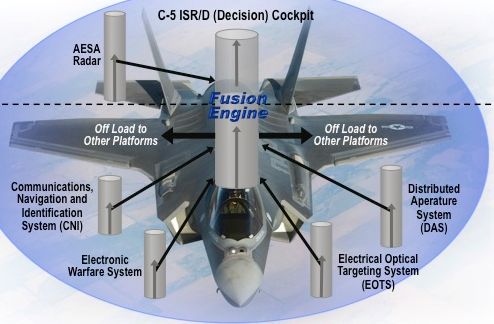
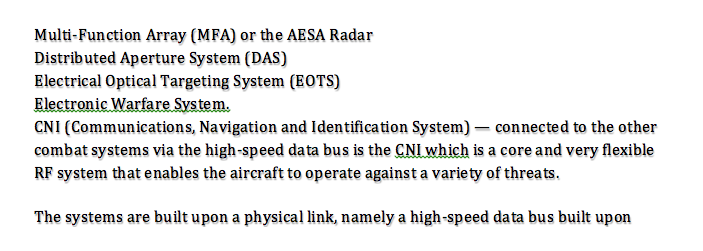
Col John Boyd’s OODA loop formula was a brilliant insight in merging technology, training and tactics. TacAir development was in a never ending quest to quest to always achieving “SA”–Situational Awareness—the Observe/Orient part of OODA.
And because of the technology limitations of Command and Control battle management was focused on building a better and better “Observe Orient” half of his OODA formula”, AWACS and Navy E-2s are examples of providing “bogy Dope” to a radar empowered fighter.
With the F-35 Cockpit Z-axis the key words are actually now embedded in the second half of Boyd’s OODA –the words “decide, act.”
The quest for US way of war to always fight and win is to now embrace the entire spectrum of Boyd’s OODA by not questing just for Situational Awareness, because that is only half way but rather everything should is now focused on developing technology, training tactics and C&C at all levels to empower “Situational Decisions.”
Consideration has to be taken into account of the F-35 active systems, both radar and DAS but also the combat revolution of attacking in a stealth aircraft using state-of-the-art passive sensing beyond anything ever seen in combat.
This is the true revolutionary step beyond just SA that the “z-axis” F-35 “fusion engine” brings to the fight as a catalyst for a 21st Century refocused way of support equipping and training all Service joint con-ops.
General Mike Hostage, then Commander of the USAF Air Combat Command captures this dynamic of 5th gen and F-35 perfectly:
People focus on stealth as the determining factor or delineator of the fifth generation. It isn’t; it’s fusion. Fusion is what makes that platform so fundamentally different than anything else. And that’s why if anybody tries to tell you hey, I got a 4.5 airplane, a 4.8 airplane, don’t believe them. All that they’re talking about is RCS (Radar Cross Section).
Fusion is the fundamental delineator. And you’re not going to put fusion into a fourth gen airplane because their avionic suites are not set up to be a fused platform. And fusion changes how you use the platform.
Editor’s Note: This is the second of three part series.
At the end of the series, a Special Report entitled “Shaping a 21st Century Approach to Tron Warfare” will be made available to our readers.

